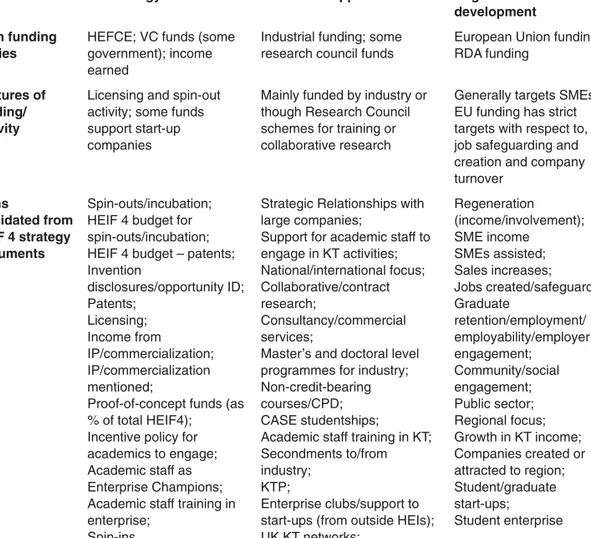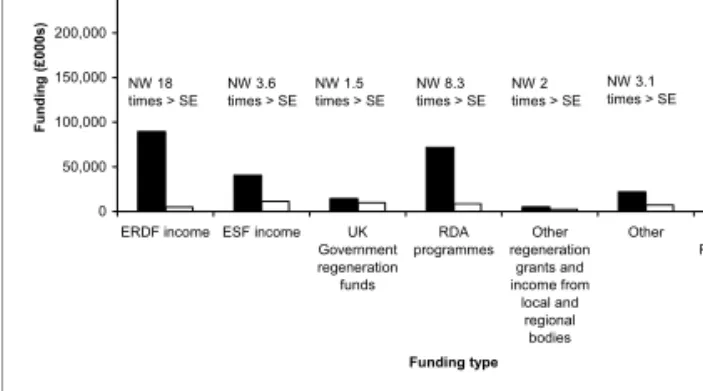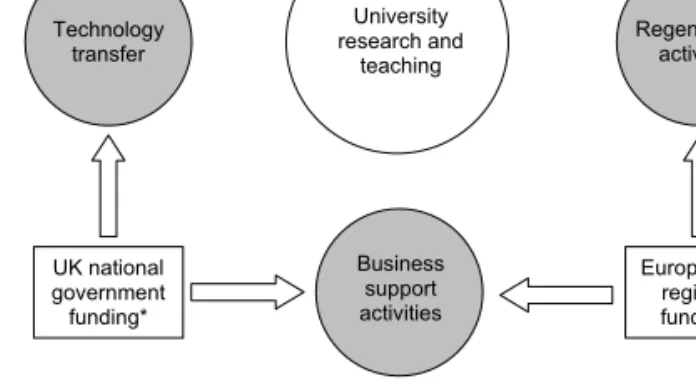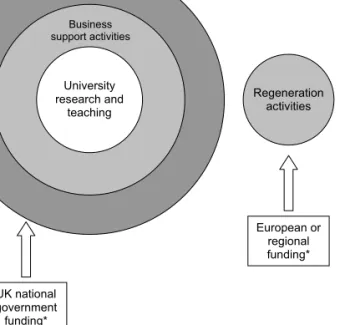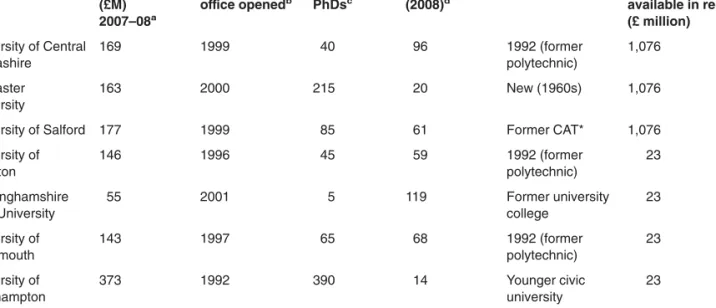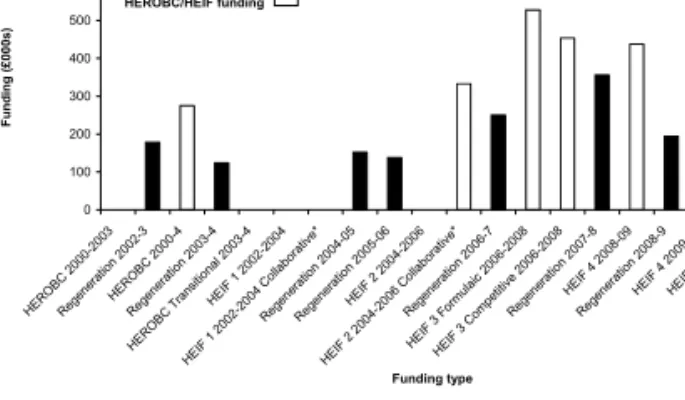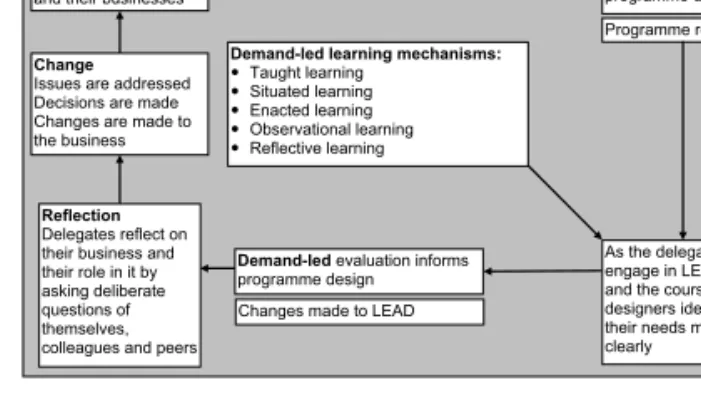Universities and economic development activities
A UK regional comparison
Moira Decter, Frank Cave, Mary Rose, Gill Peers, Helen Fogg and Susan M. Smith
Abstract:
A number of UK universities prioritize economic development or regeneration activities and for some of these universities such activities are the main focus of their knowledge transfer work. This study compares two regions of the UK – the North West and the South East of England – which have very different levels of economic performance. Quantitative data from the UK government’s Higher Education Business and
Community Interaction Survey are used to track economic development funding and activity from universities in these two regions. Strategy documents prepared for the fourth round of the government’s Higher Education Innovation Fund are analysed to aid interpretations. Elements of evolutionary theory are used to explore the reasons for the differences and a case study of one university programme, Leading Enterprise and Development, is provided as an illustrative example.
Keywords:
knowledge transfer; economic development; regeneration; UK
The authors are with the Institute for Entrepreneurship and Enterprise Development, Lancaster University Management School, Lancaster LA1 4YX, UK. Corresponding author: Moira Decter. E-mail: m.decter@lancaster.ac.uk.
The involvement of universities in the economic development of their regions is an issue of growing importance. Technological advance is often linked to economic progress and governments seeking ways to boost regional economies increasingly look to universities, amongst other organizations, to support economic growth. In recent years the UK government has recognized that ‘. . .the UK’s economic success will depend on its ability to create new knowledge and translate it into innovative goods and services’ (Brown, 2006, p 42). In the UK in general, spending on R&D has been low over the last two decades and the ‘need to follow through successful R&D with effective deployment programmes’ is recognized (DTI, 2001, p 19). Whilst UK government policy over the last
decade has included programmes to encourage general knowledge transfer (KT) from universities to industry (DTI, 2001), KT programmes specializing in
regeneration at UK universities tend to focus on providing support to small and medium-sized enterprises (SMEs).
Several UK universities engage in economic development or regeneration activities and these activities can, in some cases, form the majority of their knowledge transfer (KT) work. The range of such activities is outlined in Table 1. Economic development activities have been funded in the UK largely by the European Union (EU) through the European Regional Development Fund (ERDF) and UK Regional Development Agencies (RDAs) since the late 1990s.1
However, the amount of funding available is dependent on the level of identified economic deprivation in sub- regional areas. In the North West Region of England the economy has been described as underperforming: the North West Development Agency’s Regional Economic Strategy states:
‘Gross Value Added (GVA or output) per head is 12% lower than the England average, resulting in an output gap of £13 billion. £3 billion of this is due to fewer people working per head of population and
£10 billion is due to lower productivity (GVA per employee).’ (NWDA RES, 2006, p 3)
In contrast, as measured by GVA per head, the South East of England ‘. . .is currently the second most prosperous region in the UK behind London’. It was also ‘. . . over the period 1997–2003 . . . the fastest
growing region in the UK’. It is ‘in national terms, a highly prosperous region’ (SEEDA, 2006).
The resulting difference in levels of economic development funding has led to disparate experiences in different regions of the UK and, in the context of this paper, very different responses from universities. An unusual feature of university economic development work is that the links between industry, government and the university are via a funding model that sees government at regional or European level providing funding directly to the university. This funding requires the university to meet targets associated with the support of small to medium sized enterprises (SMEs).
Withinde minimisregulations,2this support is often free of charge for the SMEs involved. This study compares these two regions of the UK, the North West and the South East of England, which attract very different levels of economic development funding as a
Table 1. UK KT categories – an extended categorization/definition.
Classification Technology transfer Business support Regeneration/economic development
Main funding bodies
HEFCE; VC funds (some government); income earned
Industrial funding; some research council funds
European Union funding;
RDA funding
Features of funding/
activity
Licensing and spin-out activity; some funds support start-up companies
Mainly funded by industry or though Research Council schemes for training or collaborative research
Generally targets SMEs;
EU funding has strict targets with respect to, eg, job safeguarding and creation and company turnover
Items
elucidated from HEIF 4 strategy documents
Spin-outs/incubation;
HEIF 4 budget for spin-outs/incubation;
HEIF 4 budget – patents;
Invention
disclosures/opportunity ID;
Patents;
Licensing;
Income from IP/commercialization;
IP/commercialization mentioned;
Proof-of-concept funds (as
% of total HEIF4);
Incentive policy for academics to engage;
Academic staff as Enterprise Champions;
Academic staff training in enterprise;
Spin-ins
Strategic Relationships with large companies;
Support for academic staff to engage in KT activities;
National/international focus;
Collaborative/contract research;
Consultancy/commercial services;
Master’s and doctoral level programmes for industry;
Non-credit-bearing courses/CPD;
CASE studentships;
Academic staff training in KT;
Secondments to/from industry;
KTP;
Enterprise clubs/support to start-ups (from outside HEIs);
UK KT networks;
Student placements
Regeneration (income/involvement);
SME income SMEs assisted;
Sales increases;
Jobs created/safeguarded;
Graduate
retention/employment/
employability/employer engagement;
Community/social engagement;
Public sector;
Regional focus;
Growth in KT income;
Companies created or attracted to region;
Student/graduate start-ups;
Student enterprise
Source:HEIF 4 strategies from http://www.ikt.org.uk/, accessed April 2009;The European Regional Development Fund – an Introductory Guide, Office of the Deputy Prime Minister, London, 2001.
result of the difference in economic performance and examines the effects of this difference.
The topic – state of the art
University economic development activities are, in the view of the authors, a subset of the overall KT activity of a university. They do not include the additional economic benefits to a region resulting from the presence of a university such as general university or student spending or jobs at the university. Previous work by the authors has classified university KT activities into three categories: technology transfer, business support and regeneration (economic
development). These categories are outlined further in Table 1 and the rationale for this taxonomy has been outlined elsewhere (Decteret al, 2010). In this brief review, literature relating to UK KT is examined.
Although this embraces more than just university economic development activity it is reflective of the current state of the UK literature on KT. There have been very few UK academic papers that solely explore university KT activity as it relates to economic development. Those that have been identified are discussed below.
A recent review of research on the effectiveness of technology transfer concludes that ‘. . . much of it has been descriptive and approached from the perspective of inventorying the phenomenon’ (Phan and Siegel, 2006, p 44). The UK academic literature relating to direct KT from universities is relatively sparse and often uses descriptive methodologies and/or analysis of survey results. Theory-based publications are relatively rare in this field (Chell and Oakey, 2005; Phan and Siegel, 2006; Nicolaou and Birley, 2003; Rothaermelet al, 2007). There also appears to be little use of theory brought to bear on the choices made by individual universities in terms of KT work. Phan and Siegel suggest that ‘the use of institutional theory and evolutionary economics perspectives to explain the persistence of differences in effectiveness across regions may be a fruitful direction in which to take the research related to regional development and university
technology transfer’ (Phan and Siegel, 2006, p 44).
Previous work by the present authors has used evolutionary theory to examine influences on universities, including the Research Assessment Exercise (RAE) which reinforced a preference for pure, rather than applied, research (Decter, 2009); and the range and levels of UK university KT activities (Decter et al, 2010).
The UK KT literature has a focus on entrepreneurship, particularly spin-out company formation, amongst academics. For example Franklinet alexamine the role
of surrogate (or external) entrepreneurs in university spin-out companies (Franklinet al, 2001). Lockett and Wright explore ‘. . .the extent to which the capabilities of technology transfer offices are important influences on the generation of university spin-outs within the context of universities’ resources and environments’
(Lockett and Wright, 2005, p 1044). Government reports look for trends and classifications of university types which are unrelated, and possibly irrelevant, to university knowledge transfer behaviour. This study seeks to understand more clearly the influences that affect decisions to undertake particular types of KT activity relating to regeneration.
There is little evidence of published research which examines KT at individual universities and the impact of KT on regional regeneration. Benneworth and Charles do examine university spin-off companies and their effects on the economic development of regions, comparing Newcastle in the UK with Twente in the Netherlands. This work focuses on university spin-offs rather than indigenous companies, however, and recognizes that these companies may not remain within the region (Benneworth and Charles, 2005).
Exploring a regional perspective on economic development issues similar to the one undertaken here, Huggins and Johnston examine the ‘. . .differences in the relative contribution of HEIs across regions’
(Huggins and Johnston, 2009, p 1088). They develop
‘. . .a range of measures by which to analyse differences in the value added and labour productivity of
universities at an institutional and regional level, as well as their knowledge commercialization capabilities’
(Huggins and Johnston, 2009, p 1089). Universities are classified by Huggins and Johnston according to whether they are ‘pre-1992’ or ‘post-1992’ (in 1992 polytechnics were given university status – thus
‘post-1992’ includes the former polytechnics).
Unfortunately this simple categorization fails to recognize the pre-1992 institutions which also have roots in providing technical support to industry. Regions of the UK are also categorized simply as either
‘competitive’ or ‘uncompetitive’. The ‘regional economic relevance of HEIs’ is calculated through
‘. . .the value added generated by institutions as a proportion of the total value added generated across regions as a whole’ (Huggins and Johnston, 2009, p 1093). Because the study takes account of data for one academic year only, that is 2005–06, it does not measure any changes within these regions: as a result, the increasing involvement of many universities has been omitted. The authors admit that their approach is
‘rather binary in nature’ and suggest that the true picture is more complex (Huggins and Johnston, 2009, p 1100).
We address some of this complexity in this study.
Because the UK literature on knowledge transfer is still rather limited in volume, there are actually many gaps in this body of work. Some of these have been filled in the American literature, but only with reference to that country. It has been pointed out that ‘. . .the contrasting historical evolution of the modern university systems of the United States and the nations of Europe means that the conclusions of studies of university–
industry research interactions and technology transfer in the United States may not apply to the European context’ (Geuna and Mowery, 2007, p 68). The heterogeneity of UK university KT activity has been mentioned by several researchers, but they have not dealt with the reasons for these differences in approach in any meaningful way (Meyer and Tang, 2007;
Chappleet al, 2005; Geuna and Mowery, 2007). The variety of KT activities undertaken by universities has been noted in this research and is outlined in Table 1.
An extensive literature search has shown no evidence of the use of an evolutionary theory approach to UK knowledge transfer from universities (other than that of the present authors). The influences on individual UK universities to engage in regional economic development activities have not been explored. In this study, evolutionary theory is used as a framework for analysis of UK university regional regeneration activities.
Evolutionary theory and the development of university knowledge transfer
Evolutionary theory in economics analyses the rationale for and outcomes of the actions of firms. Nelson and Winter detail the adaptation of the features of Darwin’s evolutionary theory into a tool in the field of economics (Nelson and Winter, 1982). Evolutionary theory likens the economic system to a biological one. It uses the mechanisms outlined in Darwinian theories of evolution to describe economic phenomena which previously had not fitted well with more traditional economic treatments. Here, the tenets of evolutionary theory are used to explore UK universities and their engagement in regeneration activities. Evolutionary theory is useful because it accommodates discussion of how an organization comes to behave in a particular way. In other words, we can analyse the evolution of the organization in the face of external factors and the historical influences that shape an organization’s behaviour. Also, the ideas of path dependence and creation are useful concepts in exploring the responses of universities in the context of economic development.
The development of routines in organizations and the concept of search, akin to mutation in Darwin’s theory of evolution, are the key elements of evolutionary theory used in this study (Nelson and Winter, 1982;
Nooteboom, 1997; Nelson, 2006). The development of routines can be useful to organizations: according to Hodgson (1998, p 416), ‘Routines in the firm have a relatively durable quality through time. They may help to retain skills and knowledge, and to some extent they have the capacity to replicate through imitation, personal mobility, takeovers, and so on’. However, routines can also prevent organizations from changing.
‘Survival requires a balance of, on one hand, routine, habit, conservatism, continuity, and on the other hand, adaptability, innovation, shift’ (Nooteboom, 1997, pp 63–64). Routines can act as a kind of organizational memory enabling efficient operation, but they can also restrict the ability of an organization to adapt and innovate (Hodgson, 1998; Nooteboom, 1997).
The manner in which KT activities have developed at universities is of interest. Garud and Karnøe (2001, p 2)
‘. . . offer a contrasting perspective that we term path creation. In our view, entrepreneurs meaningfully navigate a flow of events even as they constitute them’.
In this perspective the decision to engage in regeneration activities, which is quite different to normal university routines, is taken deliberately in order to create a new direction for the university.
The influence of the UK’s Research Assessment Exercise (RAE) may have unintentionally produced a path-dependent response: this has been discussed in previous work (Decteret al, 2010). Although established to allow for selective research funding, the RAE appears to have a wider effect on universities.
Antonelli (1997) states, ‘The trajectory of a path- dependent process however cannot be fully anticipated on the basis of the original events’. In universities these concepts can be applied to the continuation on or deviation from a specific path involving particular forms of knowledge transfer – in this analysis, regional regeneration activities.
Hodgson discusses the selection of maximizing behaviours and the likelihood that the objectives of firms differ in this respect. ‘With a multiplicity of adaptive peaks the path followed and thus the peak obtained is path-dependent: a result of history’
(Hodgson, 1998, p 422). The ‘. . . twin propositions from evolutionary theory of persistence and differences in firms’ activities’ are examined in Helfat’s study.
Persistence is related to ideas of path dependence (Helfat, 1994, p 1721). In the context of university KT in the UK, over the last decade there has been a multitude of funding opportunities and a wide range of resulting KT patterns developed at different universities (Decteret al, 2010). This is a similar proposition to the ideas expressed above relating to adaptive peaks and perhaps akin to the early stages of new growth in regions described by Kenney and von Burg:
‘Both economists dealing with innovations and industrial geographers studying regional industrial growth find that often there is an initial period of openness with a number of contenders prior to the selection of a dominant design or dominant location.
It is at such moments that the small events can result in the long-term differences.’ (Kenney and von Burg, 2001, p 130)
It is too early in the development of KT at UK universities to say definitively which, if any, of these patterns will be enduring ones. Many UK universities are dependent on external funding for KT activities to continue. In UK University KT terms, regional regeneration activities are one of a range of KT contenders currently being explored by some universities. It may be that a dominant design in UK university KT will emerge, but this has yet to happen. It remains to be seen whether or not regeneration activities will become dominant in some regions in the future.
Research focus
In this study two regions of the UK are compared, the North West and the South East of England, which attract very different levels of economic development funding. The effects of this difference are examined. For example, in the North West of England the European Regional Development Fund (ERDF) has had £1,076 M available for projects in the region for the period 2000–06 for Objective 1 and 2 areas. In the South East of England, however, the amount was £23 M for the same period.
Factors which influence UK universities to engage with economic development activities are considered. It would be simple to assume that universities become involved in regeneration as a response to available funding. By examining universities in two regions of the UK, with very different levels of funding, it is possible to explore the effect of funding. In order to do this the relative levels of regeneration activities, and funding, must be established for universities in the North West and South East regions of England. Figure 1 shows the aggregates of various types of regeneration funding for the six academic years 2002–03 to 2007–08.
In all cases the level of funding is higher in the North West region than in the South East, although there is substantial variation depending on the funding body.
When regarded as total regeneration funding, though, the ratio is approximately 5.5:1 (NW:SE). Although the inclination to engage in regeneration activities might be for reasons beyond those solely to do with funding, it is likely that the level of funding will affect the ability to undertake such activities. While external funding is
important to maintain university engagement in economic development, other factors influence the decision to embark on regional regeneration projects.
Methodology
Quantitative data from the UK government’s Higher Education Business and Community Interaction (HEBCI) Survey have been used to track economic development activity from universities in the two UK regions. Figures 1, 5 and 6 illustrate this approach. To develop Figure 1, HEBCI data relating to regeneration funding were aggregated from surveys for the years 2002–03 through 2007–08 (HEFCE, 2006; HEFCE, 2007; HEFCE, 2008; HEFCE, 2009). Figures 5 and 6 show the total numbers of SME contracts in the local Regional Development Agency (RDA) area. These figures are the sum of consultancy, contract research and facilities and equipment contracts for the six academic years 2003–04 to 2008–09. This second set of data covers a period one year later than the first due to the changes in availability of data in the HEBCI surveys for 2002–03 and 2008–09. HEBCI data have also been used to construct Figures 7–13 which illustrate the KT funding received by universities that have been selected for further study: these are discussed in detail in later sections.
This analysis of the levels of regeneration activity provided a basis for selection of universities for study.
From this initial analysis 12 universities, five in the North West and seven in the South East, have been identified as potentially engaging in regeneration activities (see Table 2). It is not possible, using the available data, to ascertain whether a contract with an SME in the region has been undertaken as part of a government funded regeneration programme. For example such contracts may be undertaken with
(5')LQFRPH (6)LQFRPH 8.
*RYHUQPHQW UHJHQHUDWLRQ IXQGV
5'$
SURJUDPPHV 2WKHU UHJHQHUDWLRQ
JUDQWVDQG LQFRPHIURP
ORFDODQG UHJLRQDO ERGLHV
2WKHU 7RWDO 5HJHQHUDWLRQ
)XQGLQJ
)XQGLQJW\SH
)XQGLQJ V
1RUWK:HVW 6RXWK(DVW
1:
WLPHV!6(
1:
WLPHV!6(
1:
WLPHV!6(
1:
WLPHV! 6(
1:
WLPHV! 6(
1:
WLPHV! 6(
1:
WLPHV! 6(
Figure 1.Regeneration funding aggregate for academic years 2002–03 to 2007–08.
Source:HEBCI Surveys (HEFCE, 2006; HEFCE, 2007; HEFCE, 2008; HEFCE, 2009).
well-funded small businesses that pay the university directly for services: in such cases the contract is more likely to be part of a business support programme.
These differences are discussed later in this paper.
To determine the likely provenance of SME contracts, qualitative data were analysed. Strategy documents prepared in the form of answers to a set of questions by each university in compliance with the fourth round of the UK government Higher Education Innovation Fund (HEIF) were used in two ways (HEFCE, 2008a). First, a large number of strategy documents was analysed to develop models and
definitions of different types of KT activities undertaken by UK universities. Second, individual strategies were analysed to determine whether regeneration activities are undertaken with a view to regional regeneration or whether SME contracts are undertaken due to other motivations.
For the latter analysis, HEIF 4 strategies were analysed using Wmatrix, a data-driven software tool for linguistic analysis through corpus comparison. The Wmatrix results have been used to support interpretation of HEIF 4 strategies and allow the researcher to check the context of significant words to ensure that
interpretations are correctly assigned (Rayson, 2003).3 Initially ‘key word cloud’ diagrams for each of the strategy documents were examined to seek evidence of regeneration/economic development ‘buzz’ words.4 These words were then checked with regard to the context in the main body of the text to ensure correct interpretation. Buzz words were not used as a substitute for reading the text, but rather as a helpful indicator.
Without corroborating quantitative evidence it is difficult to distinguish strategies that accurately describe a university’s commitment to a particular course of action from those that merely espouse the jargon and rhetoric of the day. For this reason interviews were carried out and quantitative data relating to funding patterns and SME contracts were also analysed.
Using this method, the Universities of Brighton, Buckinghamshire, Portsmouth and Southampton appeared to have the strongest regeneration focus in the South East. In the North West region all five of the universities listed in Table 1 had some focus on regeneration; but, using the method described above, this focus was found to be strongest at UCLAN and the Universities of Lancaster and Salford. Further discussion will focus on these seven universities, as highlighted in Table 2. HEIF 4 strategies for these universities are examined in more detail to provide perspectives on their approaches to KT activity. In addition, other relevant data acquired from interviews, university websites and the Higher Education Statistics Agency (HESA) are discussed.
A case study of one regeneration programme, developed at Lancaster University using research findings, has been included to provide further insight into regeneration activities. Named ‘Leading Enterprise and Development’ (LEAD), the programme aims to contribute to raising regional productivity, competitiveness and skills by addressing issues of leadership within the context of the SME sector generally and in particular in the owner–manager’s business. The case study has been included both to illustrate a successful university regeneration
programme and because the approach has enabled one university department to embrace KT activity as an equal part of its overall activities alongside research and teaching. Both the path creation involved and the ability of that department to absorb KT activity as part of its
‘routine activity’ are of interest here.
Findings
Definitions and models of UK KT activity
Regeneration activity in the UK has been described as being typically characterized by engagement with Regional SMEs (Decteret al, 2010). HEIF 4 strategies have been used to determine the full range of KT activities undertaken in English universities. A spreadsheet of university KT activities was developed through analysis of 39 of the 133 HEIF strategies published: the KT activities discussed in the strategy documents were listed in the spreadsheet for each of the universities. Most of these activities were common to more than one university and they appeared to fall into three broad categories, as perceived by Decteret al.
These categories have been defined as technology transfer, business support and regeneration.
Table 1 shows a summary of this extended
categorization including funding, features and a list of the types of activities that would fall into each category.
The following paragraphs and Table 1 provide a
Table 2. North West and South East universities potentially engaged in regeneration.
North West South East
University of Central Lancashire*
(UCLAN)
University of Brighton*
Lancaster University* Buckinghamshire New University*
University of Liverpool University of Oxford Liverpool John Moores University University of Portsmouth*
University of Salford* University of Reading University of Southampton*
University of Surrey
*These universities have been studied in detail (see Table 3).
definition of each of the three categories; technology transfer, business support and regeneration.
Business supportis closest to ‘normal’ academic pursuits because it involves research funded wholly or partially by industry or teaching to industry participants.
The normal routines of universities are research and teaching, so business support activities are an extension of these and therefore relatively easily undertaken by many universities. In evolutionary theory terms this is a path-dependent approach to university KT.
Technology transferinvolves a move away from normal routines towards a more commercial outlook, either through the university’s own motivations or encouraged by funding streams. From an evolutionary theory perspective, UK universities that have been involved in technology transfer, prior to the advent of KT funding in the late 1990s, have unusual ‘routines’. They have followed a different path, perhaps because these universities retained routines established in their early history, which involved a strong connection to industry, or because of a deliberate departure (that is, path creation).
Regeneration /economic development activitiescan indicate the influence of European and regional development agency funding. These activities are quite clearly a long way from the normal routines of UK universities and indicate elements of deliberate path creation (see Table 1 for examples). In the main, activities involve working with small companies in the local region, a major departure from expected routines of research and teaching.
It should be noted that economic benefits may accrue from any of these three types of KT activities. However, those labelled here (Table 1) as regeneration activities are funded and undertaken with the purpose of promoting economic development within a specific region or sub-region. In addition they are the types of university KT activities that are most likely to succeed in this purpose because they direct resources to SMEs already based in the disadvantaged region. Technology transfer activities, for example, are more likely to be targeted at companies licensing technology from outside the region or indeed country, or spin-out companies that may exit through a trade sale or move to a more prosperous region.
Figures 2–4 illustrate the relationships between KT categories at UK universities with different KT landscapes. Figure 2 illustrates a scenario in which the university focuses solely on pure research and teaching and KT activities may exist but are not embedded in the university. This represents what might be expected of a
university fully conforming to established university routines in the UK: that is, a strong emphasis on research and teaching with KT activities undertaken solely due to external funding and government pressure.
In Figure 3, business support activities are depicted as embedded as routine and there is some intrinsic motivation to undertake technology transfer, but regeneration activities are undertaken as one-off projects and do not form part of ‘business as usual’. In this case one might theorize that the university undertakes business support naturally as a result of its history, either due to a lack of research funding from government sources, or due to continuing long-term links with industry. A long, uninterrupted history of industry links would allow the university to adopt a stance in which the pursuit of pure research and maintaining what have always been considered appropriate associations with industry can co-exist. A reduction in research funding from government, such as that experienced by some universities after the first
8.QDWLRQDO JRYHUQPHQW
IXQGLQJ
(XURSHDQRU UHJLRQDO IXQGLQJ 8QLYHUVLW\
UHVHDUFKDQG WHDFKLQJ 7HFKQRORJ\
WUDQVIHU 5HJHQHUDWLRQ
DFWLYLWLHV
%XVLQHVV VXSSRUW DFWLYLWLHV
Figure 2.Knowledge transfer activity – low level of university engagement.
Note:* External motivations (for example, funding).
8.QDWLRQDO JRYHUQPHQW
IXQGLQJ
(XURSHDQRU UHJLRQDO IXQGLQJ 8QLYHUVLW\
UHVHDUFKDQG WHDFKLQJ 7HFKQRORJ\
WUDQVIHU 5HJHQHUDWLRQ
DFWLYLWLHV
%XVLQHVV VXSSRUWDFWLYLWLHV ,QWHUQDOPRWLYDWLRQV
Figure 3.Knowledge transfer activity – business support embedded.
Notes:* From university history or individual academics;
** External motivations (for example, funding).
RAE, may lead to a university turning to industry to maintain levels of research activity. The University of Surrey has taken this approach (see Interviews, University of Surrey, 2008). Some intrinsic motivation to carry out technology transfer might also be expected to emerge from existing connections with industry.
In the third scenario (Figure 4) both business support and technology transfer are normal parts of university business. In these universities norms of behaviour include not only research for and teaching to industry but also an acceptance of a ‘legitimacy’ in licensing technologies and spinning-out companies. This culture might arise due to early successes in these areas leading to enhanced university funding, rejection of the
prevailing culture in UK universities or the belief that such activities might co-exist with, or even enhance, pure research.
One might speculate on a situation in which regeneration activities become embedded as routine in universities. However if the variation in levels of regeneration activity correlate with levels of external funding this model is unlikely to be appropriate. Data examined in the following section may shed some light on this area. There has been some speculation in the literature as to which types of universities might embrace different types of KT activities (Shattock, 2009; Holiet al, 2007). This will be examined taking into account age, size and types of university as well the effects of regional location and funding.
SME engagement
Figures 5 and 6 show the total aggregated number of contracts with SMEs within the areas of the RDAs for the North West and South East. With the exception of Buckinghamshire New University there is a much lower level of engagement with regional SMEs in the South East compared to the North West. However, if the ratio of regeneration funding – North West-to-South East – is applied to the level of SME contracts, then some of the South East universities might also be considered to be engaged. In the North West region the Universities of Central Lancashire, Lancaster, Liverpool, Liverpool John Moores and Salford were strongly engaged with SMEs in the region in the period 2003–04 to 2008–09.
Taking a value of 1,500 contracts as an arbitrary cut-off point (250 contracts per year) we can divide this value by 5.5, the ratio of total regeneration funding in the two regions: a cut-off value of approximately 270 contracts in the South East region can then be justified as accounting for the lower levels of regeneration funding in the South East. Using this reasoning, the Universities of Brighton, Buckinghamshire, Oxford, Portsmouth,
8.QDWLRQDO JRYHUQPHQW
IXQGLQJ
(XURSHDQRU UHJLRQDO IXQGLQJ 8QLYHUVLW\
UHVHDUFKDQG WHDFKLQJ 7HFKQRORJ\
WUDQVIHU
5HJHQHUDWLRQ DFWLYLWLHV
%XVLQHVV VXSSRUWDFWLYLWLHV
Figure 4.Knowledge transfer activity – business support and technology transfer embedded.
Note:* External motivations (for example, funding).
8QLYHUVLW\
RI%ROWRQ
8QLYHUVLW\RI&HQWUDO/DQF DVKLUH
8QLYHU VLW\RI&KHVWHU
8QLYHUVLW\RI&XPEU LD
(GJH+LOO8QLYHUVLW\
/DQFDVWHU8QLYHUVLW\
8QLYHUVLW\RI/
LYHUSRRO
/LYHUSRRO +RSH8QLYHU
VLW\
/LYHUSRR O-RKQ
0RRUHV8QLYH UVLW\
8QLYHUVLW\RI0DQ FKH
VWHU
0DQF
KHVWHU0HWURSROLWDQ8QLYHUVLW\
8QLYHUVLW\R I6DOIRUG
1XPEHURIFRQWUDFWV
Figure 5.Total number of contracts with SMEs in NW RDA area, 2003–04 and 2008–09.
Source:HEBCI Surveys (HEFCE, 2006; HEFCE, 2007; HEFCE, 2008; HEFCE, 2009, HEFCE, 2010).
8QLYHUVLW\RI%ULJKWR Q
%XFNLQJKDPV KLUH1H
Z8QLYHUVLW\
&DQWHUEXU\
&KULVW&KXU FK8QLYHUVLW\ 8QLYHUVLW\RI&K
LFKHVWHU
8QLYHUVLW\IRUWKH&U HDWLYH$UWV
8QLYHUVLW\RI.
HQW
8QLYHUVLW\RI 2[IRUG
2[IRUG%URRNHV 8QLYHUVLW\
8QLYHUVLW\RI3 RUWVPRXWK 8QLYHUVLW\RI5HDGLQJ
5R\DO+ROORZD\8QLYHUVLW\RI /RQGRQ 8QLYHUVLW\RI6RXWKD
PSWRQ
6RXWKDPSWRQ6ROHQW8QL YHUVLW\ 8QLYHUVLW\RI
6XUUH\
8QLYHUVLW\RI6 XVVH[
8QLYHUVLW\RI:L QFKHVWHU
1XPEHURIFRQWUDFWV
Figure 6.Total number of contracts with SMEs in SE RDA area, 2003–04 and 2008–09.
Source:HEBCI Surveys (HEFCE, 2006; HEFCE, 2007; HEFCE, 2008; HEFCE, 2009, HEFCE, 2010).
Reading, Southampton and Surrey were felt to be of interest. Using the method described above, with regeneration buzz words being used to explore HEIF strategies, the Universities of Brighton,
Buckinghamshire, Portsmouth and Southampton were then identified as having the strongest regeneration focus in the South East. In the North West this focus was strongest at UCLAN and the Universities of Lancaster and Salford.
Table 3 outlines various indicators relating to these seven universities. Because these universities represent a very diverse group with regard to university type, research quality or quantity, based on RAE performance and PhDs produced, or size, based on income, it seems unlikely that these factors influence regeneration engagement. It is not possible to correlate regeneration activities with these more customary university classification methods, although recent reports have attempted to do so (Hewitt-Dundas, 2010; Sainsbury, 2007). It is argued here that it is more useful to classify universities more directly in terms of their KT
engagement profile (see Decteret al, 2010).
The availability of regeneration funding does relate to some extent to the level of activity, as already discussed. Perhaps also of interest is the date of opening of the KT office at some, but not all, of these
universities, which coincides with the earliest calls for funding bids in the late 1990s.
Funding history and KT strategy
The timing of regeneration funding in relation to other KT funding received may have an influence on regeneration engagement. Figures 7–13 show approximate chronological funding patterns for the seven universities being examined (HEFCE, 2006;
HEFCE, 2007; HEFCE, 2008; HEFCE, 2009; HEFCE,
Table 3. Variables relating to selected universities.
University Total income (£M) 2007–08a
Year KT/TT office openedb
Number of PhDsc
RAE ranking (2008)d
University typea ERDF funding available in regione (£ million)
University of Central Lancashire
169 1999 40 96 1992 (former
polytechnic)
1,076
Lancaster University
163 2000 215 20 New (1960s) 1,076
University of Salford 177 1999 85 61 Former CAT* 1,076
University of Brighton
146 1996 45 59 1992 (former
polytechnic)
23
Buckinghamshire New University
55 2001 5 119 Former university
college
23
University of Portsmouth
143 1997 65 68 1992 (former
polytechnic)
23
University of Southampton
373 1992 390 14 Younger civic
university
23
Sources:aIndividual university websites for Annual Reports and background information;bHEFCE (2008), Higher Education–Business and Community Interaction Survey 2006–07 July 2008/22 and HEFCE (2007) Higher Education–Business and Community Interaction Survey 2004–05 and 2005–06 July 2007/17;cHESA statistics Table R1 Share of research output per share of research input, weighted by cost centre 2006/07, http://www.hesa.ac.uk/, accessed June 2009;dTHES interpretation, http://www.timeshighereducation.co.uk/
Journals/THE/THE/18_December_2008/attachments/RAE_2008_THE_RESULTS.pdf, accessed December 2008;eERDF (amount available 2000–06 Objectives 1 and 2), The European Regional Development Fund – an Introductory Guide, Office of the Deputy Prime Minister, London, 2001. *College of Advanced Technology.
+(52
%&
5HJHQHUDWLRQ +(5
2%&
5HJHQHUD WLRQ
+(52%&7UDQVLW LRQDO
+(,)
+(,) &ROODERUDWLYH
5HJHQHUDWLRQ
5HJHQHUDWLRQ
+(, )
+(,) &R
OODERUDWLYH
5HJHQHUDWLRQ +(,
)) RUPXODLF
+(,)&R PSHWLWLYH
5HJHQHUDWLRQ +(,)
5HJHQHUDWLRQ +(,)
+(,)
)XQGLQJW\SH
)XQGLQJ V
5HJHQHUDWLRQIXQGLQJ +(52%&+(,)IXQGLQJ
Figure 7.KT funding pattern for University of Central Lancashire, KT office established 1999.
2010). For the three North West Universities identified as engaging in regeneration, UCLAN, Lancaster and Salford, it is clear that much of the KT funding received has been regeneration funding; that the amounts have been very large; and that this started early in their KT funding history. This may be due either to decisions taken as to the direction of the university KT programme or more directly due to the influence of
receiving funding. These three universities all state that their current KT offices opened in 1999 or 2000 when applications for such funding began – although the University of Salford had other, more commercial interests prior to this date. Lancaster University
specifically employed staff with experience in European regeneration funding (see Interviews, Lancaster
University, 2009).
+(5 2%&
5HJHQHUDWLRQ +(5
2%&
5HJHQHUD WLRQ
+(52%&7UDQVLWLRQDO
+(,)
+(,)
&
ROODERUDWLYH
5HJHQHU DWLRQ
5HJHQHU DWLRQ
+(,)
+(,)&
ROODERUDWLYH
5HJHQHUD WLRQ
+(,)) RUP
XODLF
+(, )&RPSHWLW
LYH
5HJHQHUDWLRQ +(,)
5HJHQHUDWLRQ +(,)
+(,)
)XQGLQJW\SH
)XQGLQJ V
5HJHQHUDWLRQIXQGLQJ +(52%&+(,)IXQGLQJ
Figure 8.KT funding pattern for Lancaster University, KT office established 2000.
+(52%&
5HJHQ HUDWLRQ
+(52%&
5HJHQ HUDWLRQ
+(52%&
7UDQVLWLRQDO
+(, )
+(,)
&ROODERU DWLYH
5HJHQHUDWLRQ 5HJHQHUDWLRQ
+(,)
+(,) &ROO
DERU DWLYH
5HJHQ HUDWLRQ
+(,))RUPXODLF +(,)&RPSHWLW
LYH 5HJHQ
HUDWLRQ
+(, )
5HJHQ HUDWLRQ
+(,) +(,)
)XQGLQJW\SH
)XQGLQJ V
5HJHQHUDWLRQIXQGLQJ +(52%&+(,)IXQGLQJ
Figure 9.KT funding pattern for University of Salford, KT office established 1999.
+(52%
&
5HJHQHUDWLRQ +(5
2%&
5HJ HQHUDWLRQ
+(52%&
7UDQVLWLRQDO +(,)
+(,) &ROODERUDWLYH
5HJHQHUDWLRQ
5HJHQHUDWLRQ
+(, )
+(, )&RO
ODERUDWLYH
5HJHQHUDWLRQ +(,))RUPXODLF
+(,)&R PSHWLWLYH
5HJHQHUDWLRQ
+(, )
5HJHQHUDWLRQ +(,)
+(,)
)XQGLQJW\SH
)XQGLQJ V
5HJHQHUDWLRQIXQGLQJ +(52%&+(,)IXQGLQJ
Figure 10.KT funding pattern for University of Brighton, KT office established 1996.
+(52%
&
5HJHQ HUDWLRQ
+(52%
&
5HJHQ HUDWLRQ
+(52%&7UDQVLWLRQD O
+(,)
+(,) &ROODERUDWLYH
5HJHQHUDWLR Q
5HJHQHUDWLRQ
+(,)
+(,) &
ROODE RUDWLYH
5HJ HQHUDWLRQ
+(,))RUP XODLF
+(,)
&RPSHWLWL YH
5HJHQ HUDWLRQ
+(,)
5HJHQ HUDWLRQ
+(,)
+(,)
)XQGLQJW\SH
)XQGLQJ V
5HJHQHUDWLRQIXQGLQJ +(52%&+(,)IXQGLQJ
Figure 11.KT funding pattern for Buckinghamshire New University, KT office established 2001.
+(52%&
5HJHQHUDWLRQ +(52%&
5HJHQHUDWLRQ
+(52%&7UDQVLWLRQDO
+(,)
+(,) &ROODERUDWLYH
5HJ HQHU
DWLRQ
5HJ HQHU
DWLRQ +(,)
+(,) &ROODERUDWLYH
5HJ HQHUDWLRQ
+(,) )RUP
XODLF
+(,)&
RPSHWLWLYH 5HJ
HQHUD WLRQ
+(,)
5HJ HQHUD
WLRQ
+(,)
+(,)
)XQGLQJW\SH
)XQGLQJ V
5HJHQHUDWLRQIXQGLQJ +(52%&+(,)IXQGLQJ
Figure 12.KT funding pattern for University of Portsmouth, KT office established 1997.
+(52%&
5HJHQHUDWLR Q
+(52
%&
5HJHQHUDWLRQ
+(52%&
7UDQVL WLRQDO
+(,)
+(,)
&R OODERUDWLYH
5H JHQHUDWLRQ
5H JHQHUDWLRQ
+(,)
+(,)&R OODERUDWLYH
5HJHQHUDWLRQ +(,))RU
PXODLF
+(,)&RPSHWLWLYH
5HJHQHUDWLR Q
+(,)
5HJHQHUDWLRQ +(,)
+(,)
)XQGLQJW\SH
)XQGLQJ V
5HJHQHUDWLRQIXQGLQJ +(52%&+(,)IXQGLQJ
Figure 13.KT funding pattern for University of Southampton, KT office established 1992.
